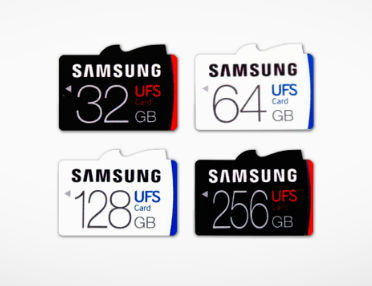UFS (Universal Flash Storage) chips are now commonly found in premium smartphones, but the UFS standard has also been published for removable cards, and Samsung has just introduced their first cards based on UFS 1.0 Card Extension Standard* for use in high-resolution mobile shooting devices such as DSLRs, 3D VR cameras, action cams and drones, as a new alternative to micro SD cards.
 Before getting into more details about the Samsung card, let’s go through the main features defined by UFS card specifications:
Before getting into more details about the Samsung card, let’s go through the main features defined by UFS card specifications:
- Based on the UFS 2.0 standard and compatible with the UFS HCI 2.0 standard
- Supports MIPI M-PHY HS-Gear3, HS-Gear2 (optional), and PWM-Gear1
- A detailed mechanical definition is defined by the JEDEC MO-320 outline
- Features common to embedded UFS 2.0 devices:
- Support for multiple logical units, each with configurable characteristics
- Reliable write and background operations
- Secure operations such as purge and erase to enhance data security
- Includes write protection options, including permanent and power-on write protection
- Provides task management and power management functionality
- Boot capability NOT supported at this time
Samsung UFS removable memory cards come in 32, 64, 128, 256 GB capacity, and the latter is said to deliver up to 530 MB/s sequential read speed, 5x times faster than typical micro SD cards, and similar to what you’d get with an SSD, as well as a random read rate of 40,000 IOPS, or about 20 times faster than a typical micro SD card. Writing performance is not too shabby either with 35,000 random IOPS, two levels of magnitude faster than typical micro SD cards achieving a few hundred IOPS, and up to 170MB/s sequential write speed. This could potentially become an excellent boot device for new development boards eventually, once/if the standard adds support for boot capability, and boards get UFS card support.
Samsung has not released any pricing info so far, but those cards are likely to be a little pricey, least at the beginning, considering they match the performance of some SSDs.
Thanks to Harley for the tip.

Jean-Luc started CNX Software in 2010 as a part-time endeavor, before quitting his job as a software engineering manager, and starting to write daily news, and reviews full time later in 2011.
Support CNX Software! Donate via cryptocurrencies, become a Patron on Patreon, or purchase goods on Amazon or Aliexpress





This would be great for development boards!, sd’s are a pain in the ***, they just aren’t relaible.
” but those cards are likely to be a little pricey, least at the beginning, considering they match the performance of some SSDs ”
In europe one can buy a 120MB (slow) SSD by 30€ or less.
I just bought a new and rather fast Intel 535 120GB (Read 540MB/s/, Write 480MB/s) for 39 Euro incl. shipping.
170MB/s sequential write speed is good but I am more interesting how is the random 4k read/write, especially on 32/64GB cards.
@peter
Intel 535 120GB
It’s a good drive but I don’t know how they achieve those numbers or I am not looking at the right SSD. Real world sequential write speed is max. 300MB/s while random 4k goes down to 20MB/s
http://ssd.userbenchmark.com/SpeedTest/28259/INTEL-SSDSC2BW120H6
Half advert but interesting reading for casual users of sdcard is this. http://thewirecutter.com/reviews/best-microsd-card/
In March 2016, the SD Association announced a new standard for memory cards that will support 360-degree, 3D, and 8K video. The new version 5.0 SD cards will feature minimum sequential write speeds of 60 MB/s and 90 MB/s, designated by the V60 and V90 video-speed-class labels, respectively. The cards will write to memory blocks as large as 512 MB, which contributes to the speed boost. Exactly when the new cards and compatible devices will hit the market is unclear, but we’ll test some for an upgrade pick when they’re commonly available.
Yes, thats the one. Not overwhelmingly fast, but still pretty decent for that price, and definitely good enough for my rather simple use cases…
@theguyuk
The Sdcards people use are actually from the camera and video world, so designed with them in mind and not single board computer.
@Igor
40k/35k random IOPS read/write
Umm, the UFS memory cards standard lists Samsung as holder of the essential patents
Patent(s): Samsung: US D727910, US D736212, US D736215, US D736214, US D736213, US 29/546125, US 29/546150
Just imagine using tens on them running in parallel: RAM-like performance